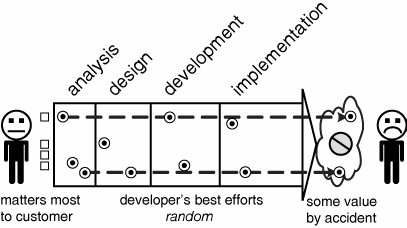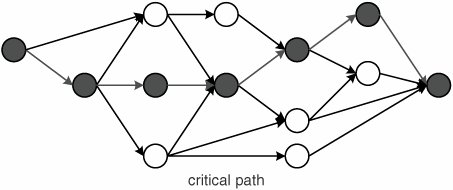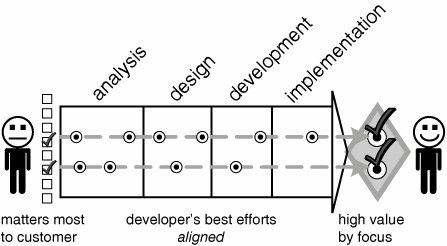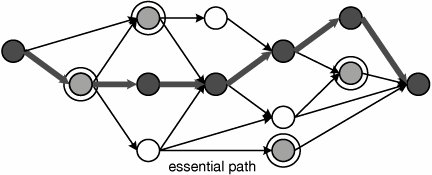Problems with New Development
| Developing new software products is challenging. Among the most pervasive challenges are problems arising from difficulties with the development process. The project manager has the primary responsibility for dealing with these difficulties. What are they, and what can QFD do to help? Incoherent Development Is InefficientOn many development projects, when the project is over, it can appear that the team's best efforts were applied without any plan or patternthat is, randomly. Indeed, there is often no correlation between how well the team did on any item, and how important it was to the customers. A simple test is to ask any developer on any project what value their best efforts provided to the customer. Most will be hard pressed to answer. Or you could ask a project manager to predict for his next phase which tasks will be performed the best. Most have no idea. So there is no plan for value, and there is no pattern to what is done best. Random best efforts are terribly wasteful of a team's talents, and they are tremendously inefficient in terms of time (see Figure 26.2). Why does this happen? Figure 26.2. Incoherent development occurs when there is no focus during development on what matters most to the customers. Doing your best on activities that don't add value is an inefficient way of building lesser products than you are capable of. Random Best EffortsThe Absence of ManagementThe simple answer is that there is no mechanism to direct the team toward what matters most to the customer. There are no tools or techniques for the project manager to use to manage value. Yet the whole purpose for new-product development is to deliver value to the customer. Without value, you have no chance of satisfying your customer (especially in a competitive environment). In order to aim the team at value-adding activities, the project manager needs a way to find out what value is for this project, and this project's customers. Then the project manager needs a way to communicate that definition throughout the projectfrom start to finish. The Critical Path Comes SecondWhat the project manager does have are tools to deal with his time, money, and people. He has a project schedule, with the critical path clearly determined (see Figure 26.3). Indeed, many project managers use the Critical Path Method (CPM), whereby they determine the critical path to see how long the project will take. Furthermore, many project managers spend more time and effort on the project schedule than on any other aspect of the project, and they are well supplied in this obsession with tools and techniques. They also have a project budget to track against, and they have assigned resources to the tasks in their project plan. But with no way to make value visible, they have no way to manage it. Schedule comes first by default. Figure 26.3. The critical path is the longest path through the activity network, and it determines the project duration. But finishing on time with a mediocre product is not success in product development. Schedule is important, but value is more important. When managing a development project, a project manager will define a business case at the beginning of the project. The business case justifies performing the project by checking to make sure the project costs are outweighed by the customer benefits: In other words, is the value we intend to produce greater than the cost of producing it? Yet project managers frequently do not use this vital analysis to direct project management on a daily basis. With Project QFD, the project manager can directly connect the business case to the project so that he can concentrate on activities that have the largest effect on making the business case come true. Finishing early or under budget will not make up for the fact that we have failed to deliver sufficient value to customers. Yes, time and money do matter, but delivering value matters more in product development. If we fail on value, then we failnothing can compensate. There is no substitute for value. So what would be a better way to proceed? Coherent Development Is EfficientInstead of wasting our teams' time and talent doing a great job on things that don't matter to our customers, we must start by being clear about what matters to our customers. The development process must be coherent, like the light of a laser, and it must be aimed at value for customers: best efforts aligned end to end on what matters (see Figure 26.4). Figure 26.4. Coherent development occurs when the project manager can focus the project on value, not just on the schedule. A small number of activities add the most value to the customerthe project manager must know which ones do that. Best Efforts: Where They Matter to the CustomerWe will need to use several tools and techniques to discover what really matters to our customers (refer to Figure 26.4). We cannot rely on our customers to simply tell us, as they are equally ill equipped to give us all of their requirements (and to tell us precisely how important each one is). It is our job to find out, but it is not their job to tell us. This is why value discovery methods are a key part of Project QFD. QFD uses a set of tools, the seven new tools for management and planning, in a systematic sequence to uncover the "voice of the customer." The new tools are presented following. These methods are simple enough to learn and apply quickly, yet powerful enough to give us confidence that we can achieve a competitive advantage [Nayatani et al. 1994, Mizuno 1989]. These tools are not newthey are the result of refinement over 20 years of application. With these tools we have a reasonable hope of discovering what matters to our customers. But can we connect that to what we manage? The Essential Path Comes FirstInstead of focusing on only the critical path and on how fast we can do our work, we must also consider the essential pathhow well we do what matters most (see Figure 26.5). And we must maintain that concern throughout the project. This Essential Path Method (EPM) is a new product development management method. Just as CPM focuses on time, EPM focuses on value. Both provide the project manager with tools and techniques to plan and manage those issues. Figure 26.5. The essential path is defined by activities that add the most value to customers. These "steppingstones" show us where best efforts produce maximum value. For efficient product development, essential is more important than critical. Value is the prime directive of product development. We must satisfy the customer, or we fail. We must deliver value, or we cannot satisfy the customer. And some tasks that are not on the critical path have a major effect on whether we deliver value. Some tasks add enormously more value than others. Those tasks are essential to our product development success. With EPM, we first work on value, and the first step is to start with the customers. We start by discovery, and then we plan how to design and develop that thinking carefully about whom we are trying to satisfy: value delivery. QFD has an excellent set of tools for working with value. How can the project manager apply them? |
EAN: 2147483647
Pages: 394



